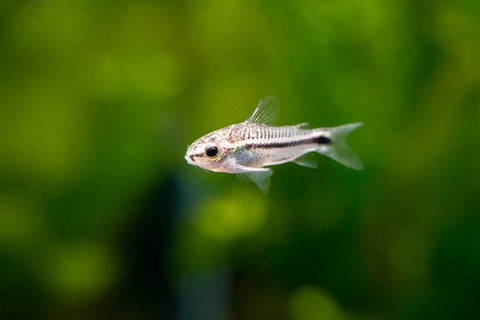Corydoras Catfish are one of the most alluring aquarium fish that are used by aquarists to add more fun to their hobby. In this article, we are going to discuss the two miniature types of Corydoras fish and will find out the difference between these two regarding their habitat, diet, etc.
Pygmy Cory
Pygmy corydoras or pygmy catfish (Corydoras pygmaeus) is a tropical freshwater fish belonging to the Corydoradinae sub-family of the Callichthyidae family.
This fish has been in the hobby for many years and is still one of the most popular dwarf corys. They are peaceful and active, small filter feeders that will not harm any other fish species if kept in a community tank.
- Lifespan: About 3 years
- Size: 1.5 inches
- Minimum tank size: 10 gallons
- Water temperature: 72 - 79°F
- pH: 6 - 7.2

Origin
Pygmy corydoras is a dwarf species of catfish, commonly referred to as cory catfish, but they are not related to the true catfish or the armored catfish. They originate from South America and are found in the slow-moving and often stagnant waters of the Amazon Basin, Orinoco Basin, Rio Paraguay, and Essequibo River in Trinidad.
In the wild, they live in areas with sandy bottoms and moderate water flow. They do not like extreme water current and should be kept in tanks with a stable water flow, such as a power filter.
Appearance
Pygmy corydoras have a translucent body with brassy or bronze coloration that is lighter on their underside, and they only reach an average adult size of around 3/4" (2 cm).
Placement in aquarium & Tank mates
In the aquarium, you should keep your pygmy corydoras in schools of 5 or more and provide them with plenty of hiding places such as rocks, driftwood, and pipes.
These fish can be very shy and tend to hide in caves or underneath large plants. If they feel threatened, they may not show themselves for days or weeks at a time.
Pygmy Corys can be kept with other peaceful community fish such as tetras, danios, rasboras, dwarf cichlids, other species of catfish and loaches.
They are not meant to be kept with aggressive or territorial fish or any aggressive invertebrates (such as shrimp). They may be kept with other varieties of Corydoras, but these would need to be introduced one at a time to prevent fighting.
Note: Because of this shyness it's important to keep them in schools of at least 3 or 4 fish to spread out their social interaction.
Diet
They are carnivores and will eat live foods like worms, insect larvae, crustaceans, and any other small aquatic invertebrates. To keep your pygmy's belly filled, offer freeze-dried bloodworms as their main staple diet with the occasional supplement of live worms or brine shrimp.
However, try to limit your feeding to 2-3 times a day, as they can overeat quickly. They are not picky eaters, however, so feel free to offer them whatever high-quality foods you can find.
Note: Pygmy corydoras are easy to feed, but it is important not to overfeed them.
Dwarf Cory
Dwarf Corydoras is one of the most popular dwarf cory catfish in the aquarium hobby. Corydoras is a genus of fish from the family of Callichthyidae.
The representatives of this genera are popular as fish for aquariums. They are popular for their small size and appreciate the peaceful environment of a community tank.
It is commonly kept in freshwater aquariums, as well as in outdoor ponds in cooler climates. Although they are extremely small, dwarf cory catfish are no less active than other members of their genus and need room to explore.
- Lifespan: 3 - 4 years
- Size: 1 inch
- Minimum tank size: 10 gallons
- Water temperature: 72 - 79°F
- pH: 6 - 7.2

Origin
It is native to the Amazon River basin in Brazil. Dwarf Cory Catfish is a bottom dweller that inhabits the smaller areas of slow-moving waters in the wild.
Appearance
Dwarf Cory Dwarf Corydoras is a very beautiful fish with long dorsal and anal fins, and it is also a very active swimmer. They are sometimes called Corydoras coscorobim. This fish has the typical shape of a Corydoras catfish, and they are hardy fish that can live in most community aquariums.
Placement in aquarium & Tank mates
Dwarf Cory Catfish are bottom dwellers that inhabit the smaller areas of slow-moving waters in the wild and do best when kept in groups, so choose at least 6 individuals to keep in the tank. You can keep them with other types of fish but please be careful as this species can be territorial and may chase off slower-moving tank mates.
Your Dwarf Cory catfish should be kept in an aquarium of 10 gallons or more, with plenty of hiding places, plants, and driftwood to provide them with more security. With a well-planned setup, you can keep at least 6 dwarf Corys together.
Diet
Dwarf cory catfish is a curious omnivore whose diet consists primarily of meaty foods. The fish will eat most types of food, including sinking pellets as well as freeze-dried and live foods such as brine shrimp, bloodworms, and daphnia.
Behavior comparison between Dwarf Cory and Pygmy Cory
If we talk about their behaviors, both fish are active schooling fish. They would like to spend their time in the mid-water area. Pygmy Cory likes to roam with a group of three or two. Both fish would like to have some hiding places to avoid any mishap with other tank mates.
Conclusion
In the above article, we have discussed the comparison between the two corydoras catfish. We have come up with different information like their food, tank size, parameters, origin, and behavior.
With the help of this information, you would be able to care for your Dwarf Cory and Pygmy Cory in a better way. In the end, we have provided you with the required tank decorations to keep your fish comfortable.

